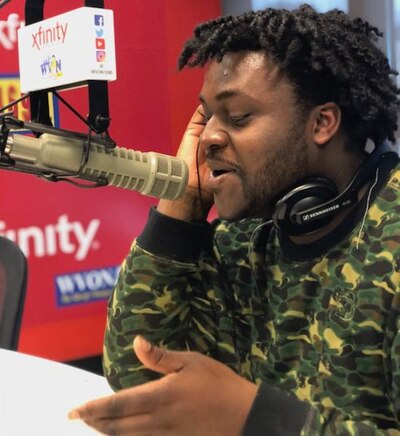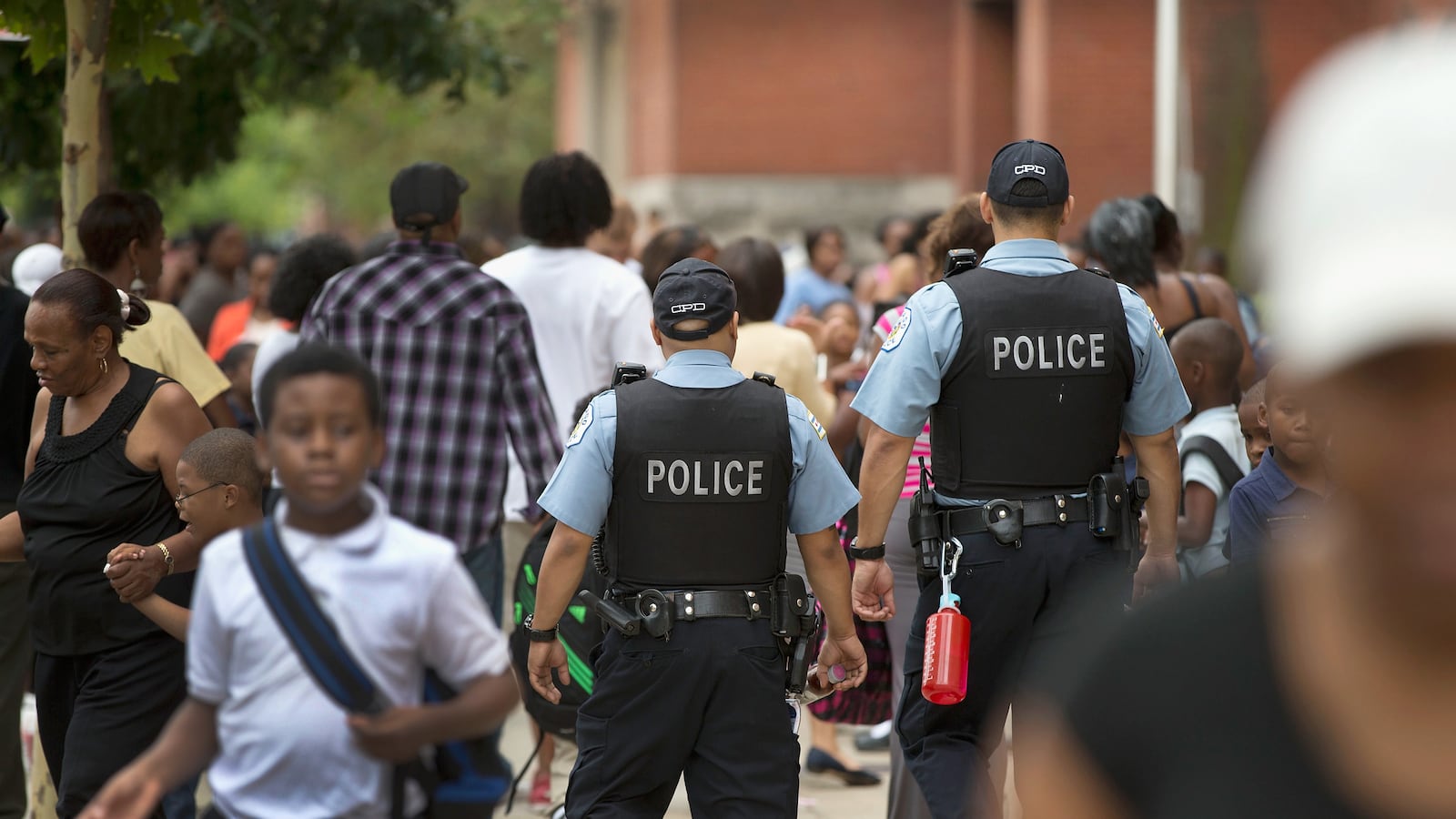Alex King remembers feeling unsettled whenever he saw uniformed police officers patrolling North Lawndale College Prep, guns on their hips.
“Seeing police in school changes the mindsets of everyone there,” said King, a 17-year-old anti gun violence activist. “It makes it feel like a jail. Why do you have to be armed around me? The more guns, the worse the situation.”
King, who lives in Austin on the West Side, said Chicago might benefit if police and black youth build a less fraught relationship, especially in schools. He hopes that a new pact governing police, including their behavior on campus, will help.

The 232-page proposed reform agreement, or consent decree, more broadly addresses problems with training, use of force, bias and misconduct at Chicago’s troubled police department. Illinois Attorney General Lisa Madigan and Mayor Rahm Emanuel negotiated the consent decree, and released it for public comment last week. A consent decree is a court order that establishes an enforceable plan whose progress is overseen and reported on by an independent monitor.
Only about four pages touch on police who work in schools, known as school resource officers, but those pages will have impact. They won’t phase out school-assigned cops like community groups demanded in May. Instead, the plan lays out ways to better screen and train them, limit use of force against students, and curb police involvement in school discipline. The mayor’s deputy chief of staff for public safety, Walter Katz, said the policies aim to improve interactions between young people and police.
“There’s a recognition that there are different challenges young people have trusting police,” he said. “This agreement is meant to address that.”
In November 2015, video was released of a white police officer named Jason Van Dyke pumping 16 shots into a black teen Laquan McDonald as he walked away from police in a daze, holding a knife. McDonald, a ward of the state, had spent most his life at CPS schools and suffered physical and sexual abuse in foster care. The video of his death intensified calls for police reform, spurring a federal Justice Department investigation that found a pattern of biased policing and unreasonable force, including in schools.
The agreement must be entered as a court order by a federal judge, who will oversee the reforms with help from an independent monitor. The reforms also face legal opposition from the city’s biggest police union, the Fraternal Order of Police. But if the draft consent decree can clear those hurdles, it could drastically change the rules for police officers at CPS schools.
Here’s how.
Police barred from school discipline
CPS has about 250 active police officers working as resource officers. The consent decree stipulates that, before the 2019-20 school year starts, CPD and CPS must formally specify how these officers may interact with students on school grounds. The memorandum of understanding would have to include “an express prohibition on the administration of school discipline by CPD officers.”
Currently no clear and comprehensive written policy at CPD spells out guidelines for school resource officers.
Alexa Van Brunt, a law professor at Northwestern University and an attorney at the MacArthur Justice Center, said that having a police officer on campus without clear policies outlining their responsibilities leaves open the possibility that off-duty officers get involved in situations that educators are typically charged with handling, like two kids fighting in a hallway. This can lead to students getting hurt even worse, or arrested.
The DOJ report reviewed all use-of-force incidents for which race was recorded between January 2011 and April 2016. More than four in five youth subjected to force were black children. The DOJ report didn’t say how many of those cases happened on school grounds. But it mentions police getting involved with school discipline.
In one case, an 8-year-old girl said a CPD officer working in her school “grabbed (her) by her hair, swung her around, and choked her while breaking up a fight in a school hallway.”
CPS wouldn’t immediately provide data about how often school resource officers use force on students, but spokesman Michael Passman emailed a statement to Chalkbeat Chicago emphasizing CPS’ commitment to partnering with the police department and other stakeholders “to ensure the consent decree helps build on our current school safety strategies.”
“CPD officers play an important role in promoting safe school environments, and this process will help strengthen the value they provide our school communities,” Passman said.
The school district’s Student Code of Conduct provides some minimal rules for school staff and administrators about involving police. It instructs school officials to, in a non-emergency situation, avoid contacting police merely to remove a disruptive student from class, and make reasonable effort to contact a student’s parent or guardians before contacting CPD. The policy states that school staff don’t have the authority to decide whether a student is arrested, and that police officers lack the authority to decide if a student receives “extra interventions or consequences as school.” But critics say the rules aren’t comprehensive enough, and don’t always match the reality of how police work in schools.
Mo Canady, executive director of the National School Resource Officer Association, which trains school police, said the policies should clarify the duties of officers in schools, including their role in discipline.
“I can’t imagine being in a situation where there’s no written policy about a school resource officer,” he said. “Policing in a school environment is a unique assignment in law enforcement that requires a unique approach.”
Canady said the lack of a clear policy creates a legal liability for the school district and police department, especially if lawsuits arise over problems involving officers. The Sargent Center on Poverty Law released a report finding that between 2012 and 2016, police assigned to CPS schools cost the city more than $2 million in misconduct settlements related to incidents on and off school grounds.
School cops “discouraged” from using Tasers
The federal report found “CPD’s pattern or practice of unreasonable force includes the use of excessive less-lethal force against children,” especially Tasers.
“In one incident, officers hit a 16-year-old girl with a baton and then tasered her after she was asked to leave the school for having a cell phone,” said the federal report, published in January 2017. Police were then called in to arrest the girl for trespassing. The proposed reform agreement says that “CPD will strongly discourage the use of Tasers in schools and on students.” Officers would have to “consider the totality of the circumstances, including a subject’s apparent age, size, and the threat presented, in assessing the reasonableness and necessity of using a Taser in a school.”
Still, that’s too hazy for Van Brunt.
“‘Strongly discourage’ is vague language,” she said. “It’s very hard for us or the monitor to enforce if there’s language that’s not very clear as to its meaning. Tasers should not be used on students in general. That would be a very easy prohibition.”
School cops better vetted
Before the 2019-20 school year, the proposal requires the school district and police departments to better vet school resource officers. The goal is “to ensure that all officers assigned to work in CPS schools have the qualifications, skills, and abilities necessary to work safely and effectively with students, parents and guardians, and school personnel,” according to the draft. Currently, neither agency has screening criteria.
Van Brunt said the vetting process should screen out officers with records of police misconduct, especially those accused of discrimination or who have had problems working with youth. The ideal officer would be open to training; have a background in restorative justice — which involves perpetrators repairing the harm inflicted on victims and focuses on reconciliation as opposed to punishment; and be willing to engage in alternatives to force and arrest when children misbehave. The process should include interviews, reviews of prior employment and Chicago police records, and training, she said.
Plans for ongoing training
Police already working in schools would get special training to do their job, under the proposal.
Officers would also get annual refresher training covering “school-based legal topics, cultural competency, problem- solving, de-escalation, use of restorative approaches, youth development, and crisis intervention,” according to the draft.
Colleen Cicchetti, a child psychologist at Lurie Children’s Hospital, said it’s important for officers in schools to have a strong handle on crisis response and trauma-informed approaches to supporting students.
“One of the things we know is the risk of being shot by a police officer is much higher if you have a psychiatric illness,” she said.
Alex King, the West Side teen activist, said it’s hard for students to forget fatal encounters between police and other young black Chicagoans.
However, if police are going to work in schools, King said they should get proper training about how to engage, respect, and build positive relationships with youth.
“I hope to see the police serve and protect the community,” King said, “and not help damage it.”

